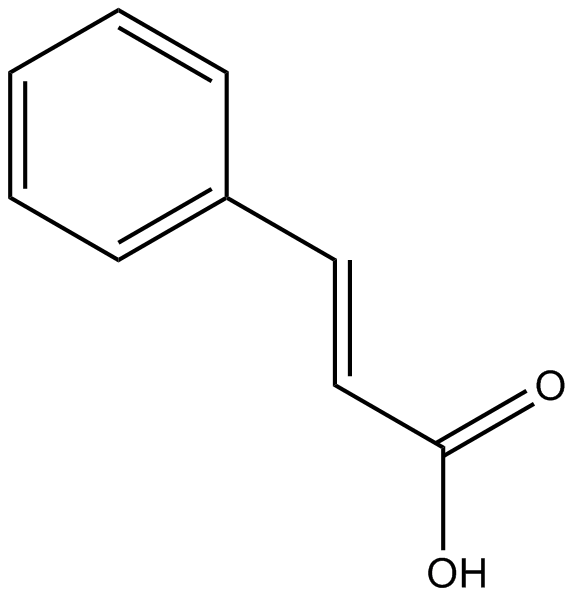Cinnamic acid (Synonyms: trans-3-Phenylacrylic acid) |
| Catalog No.GN10190 |
trans-Cinnamic acid is a natural antimicrobial, with minimal inhibitory concentration (MIC) of 250 μg/mL against fish pathogen A.
Products are for research use only. Not for human use. We do not sell to patients.

Cas No.: 140-10-3
Sample solution is provided at 25 µL, 10mM.
trans-Cinnamic acid is a natural antimicrobial, with minimal inhibitory concentration (MIC) of 250 μg/mL against fish pathogen A. sobria, SY-AS1[1].
trans-Cinnamic acid is an antimicrobial activity, with minimal inhibitory concentration (MIC) of 250 μg/mL against fish pathogen A. sobria, SY-AS1. trans-cinnamic acid shows moderate inhibition on the rainbow trout intestinal isolates A. sobria SY-AS3 and S. baltica, SY-S145, gill isolate F. spartansii SY-FS1 and fish pathogens A. salmonicida ATCC 33658, Listonella anguillarum, SY-L24, V. crassostreae SY-VC10 and Y. ruckeri E42. trans-cinnamic acid is more effective on bacteria when the pH of the culture media is not neutralized[1].
References:
[1]. Yilmaz S, et al. Antimicrobial activity of trans-cinnamic acid and commonly used antibiotics against important fish pathogens and nonpathogenic isolates. J Appl Microbiol. 2018 Sep 4.
|
Cell experiment: |
The cell lines used, established from human malignant tumors, are A549 (lung cancer); PC3(M), Du145, and LNCaP (prostate cancer); A172, U251 (glioblastoma); and SKMEL28, A375(M), 1011 (melanoma). Growth rates are determined by cell counting. Briefly, 5 X104 cells are plated in each well of a 24-well plate, allowed to attach overnight, and treated with compounds (e.g., Cinnamic acid: 2.5, 5, 10, 20, 30 mM) the following day. Cells are grown for 3 days at 37°C in the presence or absence of the drug, then detached with trypsin/EDTA and counted in a Coulter counter. Viability is determined by Trypan-blue exclusion assay[1]. |
|
References: [1]. Liu L, et al. Cinnamic acid: a natural product with potential use in cancer intervention. Int J Cancer. 1995 Jul 28;62(3):345-50. |
|
| Cas No. | 140-10-3 | SDF | |
| Synonymes | trans-3-Phenylacrylic acid | ||
| Chemical Name | (E)-3-phenylprop-2-enoic acid | ||
| Canonical SMILES | C1=CC=C(C=C1)C=CC(=O)O | ||
| Formula | C9H8O2 | M.Wt | 148.17 |
| Solubility | ≥ 7.25mg/mL in DMSO | Storage | Store at -20°C |
| General tips | Please select the appropriate solvent to prepare the stock solution according to the
solubility of the product in different solvents; once the solution is prepared, please store it in
separate packages to avoid product failure caused by repeated freezing and thawing.Storage method
and period of the stock solution: When stored at -80°C, please use it within 6 months; when stored
at -20°C, please use it within 1 month. To increase solubility, heat the tube to 37°C and then oscillate in an ultrasonic bath for some time. |
||
| Shipping Condition | Evaluation sample solution: shipped with blue ice. All other sizes available: with RT, or with Blue Ice upon request. | ||
| Prepare stock solution | |||

|
1 mg | 5 mg | 10 mg |
| 1 mM | 6.749 mL | 33.745 mL | 67.49 mL |
| 5 mM | 1.3498 mL | 6.749 mL | 13.498 mL |
| 10 mM | 0.6749 mL | 3.3745 mL | 6.749 mL |
Step 1: Enter information below (Recommended: An additional animal making an allowance for loss during the experiment)
 g
g
 μL
μL

Step 2: Enter the in vivo formulation (This is only the calculator, not formulation. Please contact us first if there is no in vivo formulation at the solubility Section.)
Calculation results:
Working concentration: mg/ml;
Method for preparing DMSO master liquid: mg drug pre-dissolved in μL DMSO ( Master liquid concentration mg/mL, Please contact us first if the concentration exceeds the DMSO solubility of the batch of drug. )
Method for preparing in vivo formulation: Take μL DMSO master liquid, next addμL PEG300, mix and clarify, next addμL Tween 80, mix and clarify, next add μL ddH2O, mix and clarify.
Method for preparing in vivo formulation: Take μL DMSO master liquid, next add μL Corn oil, mix and clarify.
Note: 1. Please make sure the liquid is clear before adding the next solvent.
2. Be sure to add the solvent(s) in order. You must ensure that the solution obtained, in the previous addition, is a clear solution before proceeding to add the next solvent. Physical methods such as vortex, ultrasound or hot water bath can be used to aid dissolving.
3. All of the above co-solvents are available for purchase on the GlpBio website.
Quality Control & SDS
- View current batch:
- Purity: >99.50%
- COA (Certificate Of Analysis)
- SDS (Safety Data Sheet)
- Datasheet
Average Rating: 5 (Based on Reviews and 30 reference(s) in Google Scholar.)
GLPBIO products are for RESEARCH USE ONLY. Please make sure your review or question is research based.
Required fields are marked with *



















